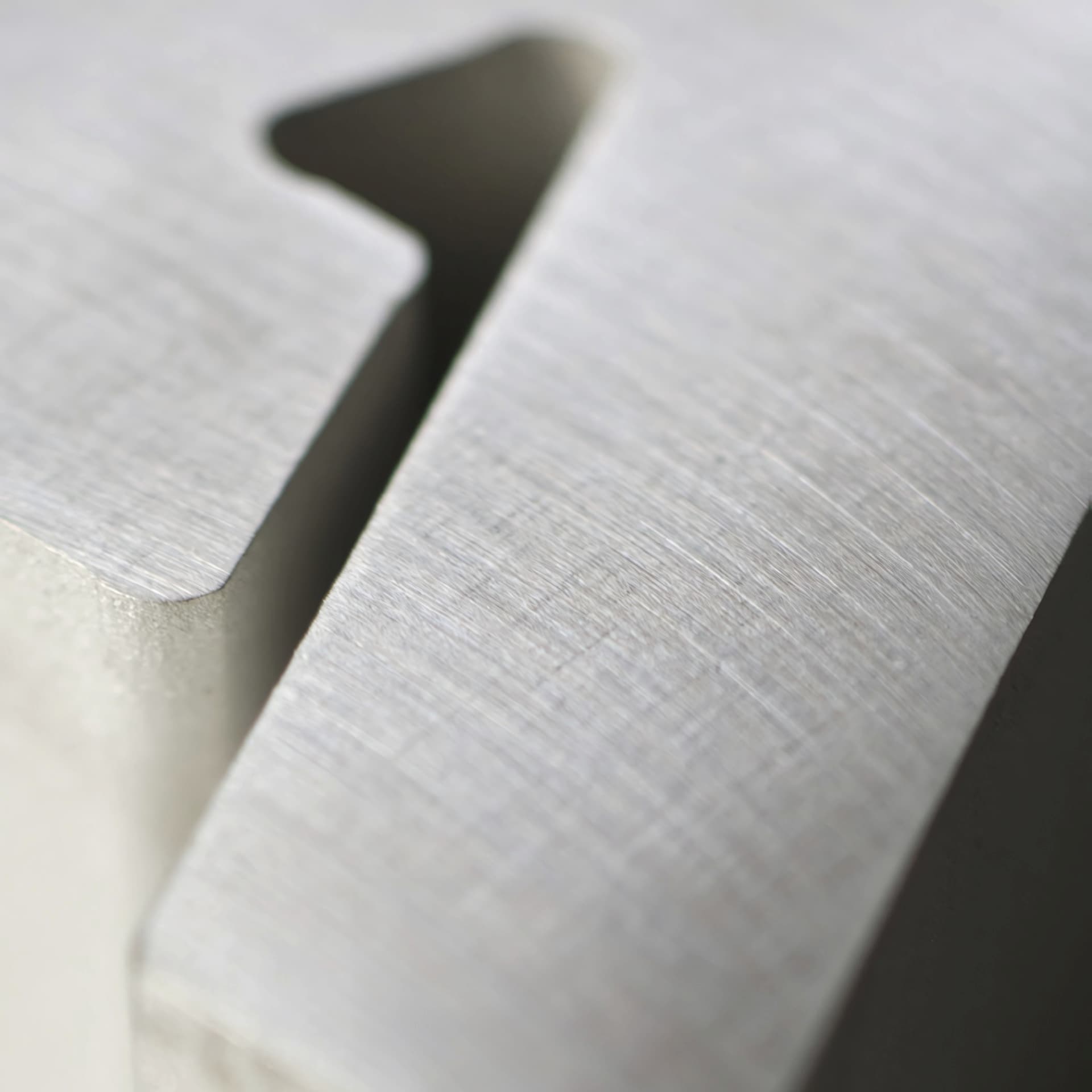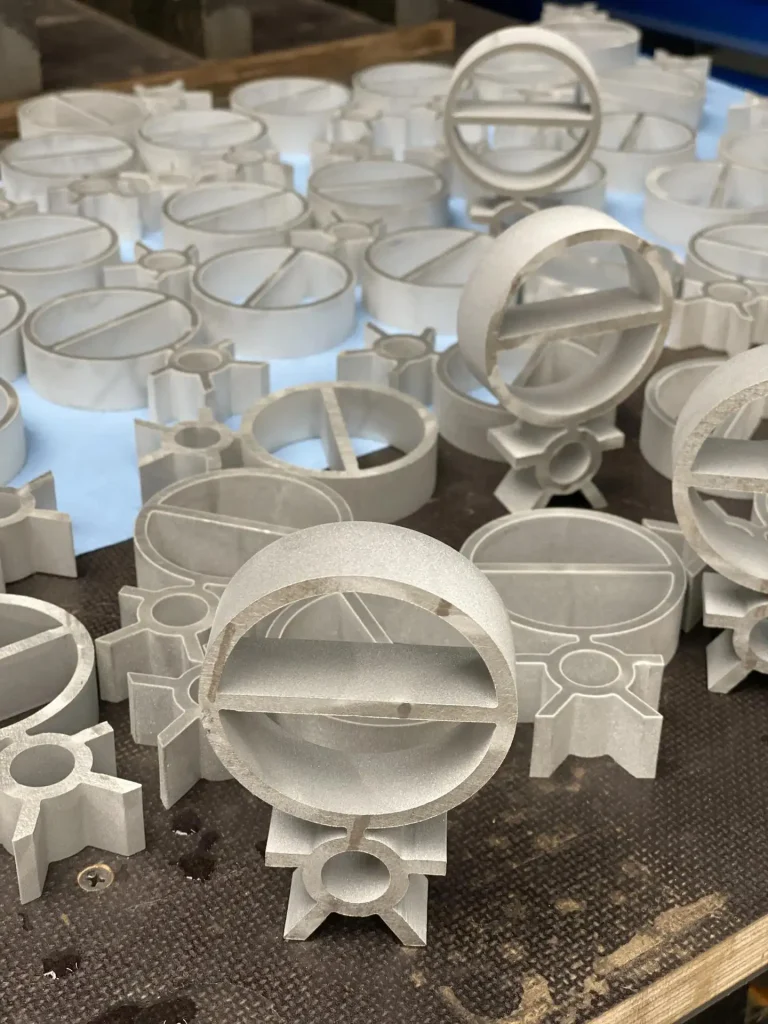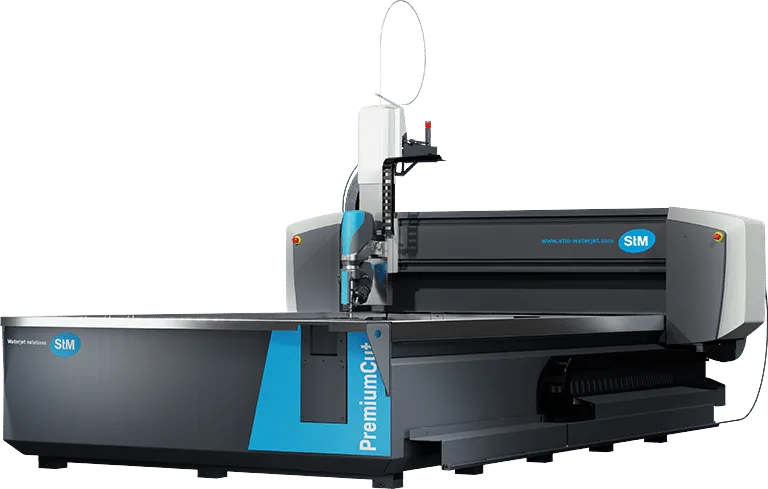Waterjet cutting metal
Steel, stainless steel, aluminum, copper, titanium and more.
Waterjet cutting is a cutting process that offers high precision and quality and is particularly suitable for cutting metal.
A major advantage of waterjet cutting is that cutting is performed without the use of heat. As a result, there is no distortion, deformation or change in the structure of the material, nor is there any change in the material properties due to the influence of heat. Even materials that are normally difficult to cut, such as hardened steel or titanium, can be cut precisely with the waterjet.
In addition, the process is very environmentally friendly, as no harmful vapors or gases are produced and the used water can be recycled.
Table of contents
Table of contents
What types of metal can be cut?
Waterjet cutting is a cutting process that can cut a variety of metal types. In general, waterjet cutting can be used to cut all types of metals and alloys, including:
- Aluminum
- Copper
- Titanium
- Bronze
- Brass
- Stainless steel
- Steel
- Carbon steel
- Alloy steel
- Hardened steel
Want more information on cutting metal with water?
5 Advantages – Waterjet Cutting Metal
Waterjet cutting of metal offers high precision and quality, without the use of heat, which avoids distortion, deformation or structural changes.
Metals vary in their material properties and thicknesses, but waterjet cutting enables them to be cut easily and precisely. Even materials that are difficult to cut, such as hardened steel or titanium, can be cut precisely. Even with uneven surfaces of metal objects, waterjet cutting machines are able to successfully process them.
The process is environmentally friendly and leaves a smooth cut edge.
Technical details
In waterjet cutting of metal, technical details play an important role in achieving the best results. These include, for example, the nozzle size, the water pressure, the table size , and the type of cutting medium used. Depending on the desired metal thickness and cutting accuracy, these parameters must be carefully selected and adjusted.
Modern waterjet cutting systems from STM offer many options for fine tuning and guarantee the highest precision and quality when cutting metal parts.
The material thicknesses that can be cut for metals range up to 300 mm.
Any shape cuts and bevel cuts up to 68° are possible.
The cutting accuracy is +/- 0.1 mm and the cut surface is usually smooth and without burrs.
In waterjet cutting, the cut quality is basically divided into 5 quality levels.
- Separating cut Q1 (for blanks / semi-finished products)
- Standard cut Q3 (the most common cut)
- Fine cut Q5 (for optimum dimensional accuracy)
For waterjet cutting of metal, the achievable cutting speeds are usually in the range of 65 to 200 mm per minute.
The water jet is generated at a pressure of 3,500 to 6,000 bar to achieve a high cutting force.
CNC control enables precise and repeatable cutting. The STM SmartCut cutting software offers high ease of use and functionality as well as flexibility.
References
EU-funded waterjet production for metalworker Uwe Seck.
With a subsidized STM waterjet system, resourceful metalworker Uwe Seck, in the Hessian town of Bad Camberg, succeeds in making the leap from local niche supplier to regional just-in-time thausendsassa for industry.
His focus is on custom products such as company signs, garden objects and individualized gifts for private customers, as well as EN-1090-2 certified steel part series for small businesses in the region.
With an STM MasterCut gantry system, completely new business areas open up. Soon, in addition to cutting parts made of metal, he was also producing workpieces made of ceramics, wood, rubber, granite, fine stoneware, copper foam, plastic and various special materials.
STM Product Finder
Find your work system – tailored to you
The individual wishes and requirements of our customers are the measure of all things for us. In order to be able to offer customized solutions for every requirement, we have developed a special product finder.
You tell us what you need to deliver perfect work and we put together the individual components and parts, as well as the associated software perfectly and individually. And if you are unsure, let your work material try our test cut.
FAQ – Frequently asked questions
Les questions les plus fréquentes sur la découpe au jet d’eau métal
Nous avons rassemblé quelques FAQ sur le thème de la découpe au jet d’eau en métal et y avons répondu de manière concise.
Si vous ne trouvez pas la réponse à votre question, n’hésitez pas à nous contacter directement.
Can you cut metal with water?
Yes, but it takes high speed and pressure to cut metal with a water jet.
What material thicknesses are possible with waterjet cutting of metals?
Un jet d’eau permet de découper des métaux d’une épaisseur allant jusqu’à 300 mm.
Toutefois, l’épaisseur maximale exacte de métal pouvant être coupée par un jet d’eau dépend de différents facteurs tels que l’abrasif utilisé, la pression de l’eau, la vitesse de coupe et le type de métal.
Is waterjet cutting better than plasma cutting for metal?
Il est difficile de dire si la découpe au jet d’eau est généralement « meilleure » que la découpe au plasma, car les deux méthodes présentent des avantages et des contraintes différents, en fonction des exigences spécifiques de l’application.
La découpe au jet d’eau présente toutefois quelques avantages :
– La découpe à froid : Lors de la découpe au jet d’eau, le métal est découpé à température ambiante, sans générer de chaleur. Il n’y a donc pas d’influence de la chaleur ni de déformation ou de modification de la structure du métal.
– Précision : la découpe au jet d’eau offre une précision et une exactitude très élevées, car le jet est très fin et contrôlable. Cela permet de découper des formes complexes et précises avec des arêtes vives.
– Polyvalence : la découpe au jet d’eau peut couper une grande variété de matériaux, y compris des matériaux plus épais qui peuvent être trop épais pour la découpe au plasma.
– Respect de l’environnement : la découpe au jet d’eau ne génère pas de chaleur, ce qui signifie qu’il n’y a pas de dégagement de gaz ou de vapeurs nocifs.
*** Traduit avec www.DeepL.com/Translator (version gratuite) ***
How big must the nozzle be for cutting metal with water jets?
As a rule, nozzles with a diameter between 0.1 and 0.4 mm are used for waterjet cutting of metal parts.
Can you cut metal parts with water jets from any direction?
Yes, the water jet can cut metal parts from any direction. The cutting properties of the waterjet remain independent of the cutting direction and it is not necessary to place the material in a specific orientation to achieve a high quality cut.
This flexibility is one of the advantages of waterjet cutting over other cutting technologies such as laser or plasma cutting, where the cutting direction plays an important role. The waterjet can also cut complex shapes and contours, making it an ideal choice for cutting metal parts with complex geometries.
La découpe au jet d’eau génère-t-elle du bruit gênant pour le métal ?
Yes, waterjet cutting of metal generates noise, but it is usually quieter compared to other cutting technologies such as plasma cutting or cutting with a saw.
Noise exposure also depends on the size and power of the waterjet cutting system used. However, it is always advisable to wear hearing protection to prevent hearing damage, especially during prolonged cutting operations or in environments with high noise levels.
What is the perfect table size when cutting metal with water?
The perfect table size for cutting metal with waterjet cutting machines depends on the size of the metal parts to be cut.
There are various sizes of waterjet cutting tables, ranging from small tables used for machining small parts to large industrial tables used for machining large workpieces.
For smaller workpieces, a table of about 1 m x 1 m may be sufficient, while larger workpieces may require tables of 2 m x 4 m or larger. Choosing the right table size also depends on the production scale and the specific requirements of the project.
How high must the water pressure be to cut metal?
For cutting metal with water jets, a pressure of about 3600 to 4000 bar is recommended, depending on the thickness of the material and the type of metal.
The thicker the metal, the higher the pressure should be to ensure a clean cut. Too low a pressure can result in an unclean cut, while too high a pressure can cause material deformation and other damage. It is therefore important to determine the optimum cutting conditions for each metal.


